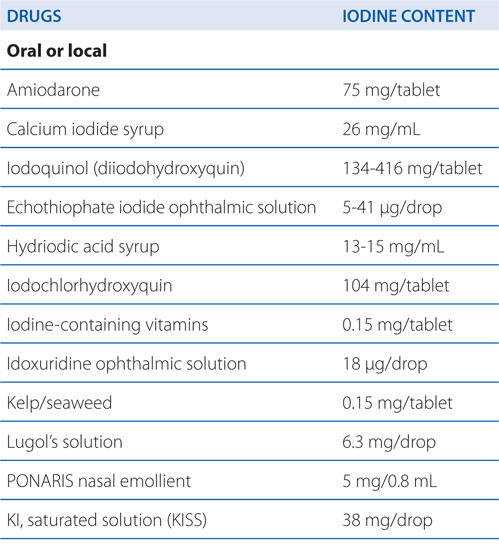27
Thyroid and Antithyroid Drugs
This chapter will be most useful after having a basic understanding of the material in Chapter 39, Thyroid and Antithyroid Drugs in Goodman & Gilman’s The Pharmacological Basis of Therapeutics, 12th Edition. In addition to the material presented here, the 12th Edition contains:
• A discussion of the chemistry and biosynthesis of the thyroid hormones.
• Figure 39-1 Thyronine, thyroid hormones, and precursors, shows the chemical structures of the thyroid hormones
• A detailed discussion of thyroid hormone metabolism and the conversion of thyroxine to triiodothyronine in peripheral tissues
• A discussion of the actions of thyroid hormone including the non-genomic effects of thyroid hormones, the effects of thyroid hormone metabolites, the effects of thyroid hormones on growth and development, and the thermogenic, cardiovascular, and metabolic effects of thyroid hormones
• Table 39-5 Selected Pharmacokinetic Features of Anti-Thyroid Drugs, shows selected pharmacokinetic features of propylthiouracil and methimazole
LEARNING OBJECTIVES
 Understand the principles of thyroid hormone regulation.
Understand the principles of thyroid hormone regulation.
 Describe the diagnosis and treatment of hypothyroidism and hyperthyroidism, including during pregnancy.
Describe the diagnosis and treatment of hypothyroidism and hyperthyroidism, including during pregnancy.
 Describe the treatment options for well-differentiated thyroid cancer.
Describe the treatment options for well-differentiated thyroid cancer.
DRUGS INCLUDED IN THIS CHAPTER
• Carbimazole (NEO-MERCAZOLE)
• Desiccated thyroid (ARMOR THYROID, others)
• Iodide
• Levothyroxine (L-T4, LEVOTHROID, LEVOXYL, SYNTHROID, UNITHROID, others)
• Liotrix (a thyroxine/triiodothyronine 4:1 mixture; THYROLAR)
• Methimazole (TAPAZOLE, others)
• Propylthiouracil
• Sodium iodine (IODOPEN)
• Sodium iodine 131I (HICON, others)
• Triiodothyroxine (CYTOMEL, TRIOSTAT, others)
MECHANISMS OF ACTION OF THYROID AND ANTITHYROID DRUGS

THYROID FUNCTION TESTS


A 69-year-old man goes to his family doctor because he has been feeling fatigued and lethargic. His doctor does a complete evaluation. This patient had a myocardial infarction and has a recurrent ventricular arrhythmia. The patient’s TSH is elevated and his T4 is slightly decreased. The doctor suspects hypothyroidism and begins replacement therapy with levothyroxine.
a. Why is the TSH elevated in this patient?
The regulation of thyroid function is shown in Figure 27-2. Thyrotropin-releasing hormone (TRH) is released from the hypothalamus when circulating concentrations of thyroid hormone (T4 and T3) are low. TRH stimulates the release of preformed TSH granules from the pituitary. The released TSH binds to a GPCR receptor on the plasma membrane of thyroid cells and eventually all phases of thyroid hormone synthesis and release are stimulated (see Figure 27-2). When thyroid hormone levels are low, the negative feedback inhibition on the hypothalamic TRH release is removed and TSH secretion is increased.
b. What factors might affect the levothyroxine dose in this patient?
Table 27-1 lists some of the factors that may influence the dose of levothyroxine. This patient has had a myocardial infarction and is being treated for a ventricular arrhythmia with amiodarone (see Chapter 18). Amiodarone is an iodine-containing drug which may impair the conversion of T4 to T3.
TABLE 27-1 Factors Influencing Oral Levothyroxine Therapy
Drugs and other factors that may increase levothyroxine dosage requirements
Impaired levothyroxine absorption
Aluminum-containing antacids
Bile acid sequestrants (cholestyramine, colestipol, colesevelam)
Calcium carbonate (effect generally small)
Chromium picolinate
Food
Iron salts
Lactose intolerance (single case report)
Phosphate binders (lanthanum carbonate, sevelamer)
Proton pump inhibitors
Raloxifene
Soy products (effect generally very small)
Sucralfate
Increased thyroxine metabolism, CYP3A4 induction of hepatic
Bexarotene
Carbamapzepine
Phenytoin
Rifampin
Sertraline
Impaired T4 → T3 conversion
Amiodarone
Mechanisms uncertain or multifactorial
Estrogen pregnancy
Ethionamide
Tyrosine kinase inhibitors (imatinib, sunitinib)
Lovastatin, simvastatin
Drugs and other factors that may decrease levothyroxine dosage requirements
Advancing age (>65 years)
Androgen therapy in women
Drugs that may decrease TSH without changing free T4 in levothyroxine-treated patients
Metformin
c. What commonly prescribed drugs are associated with iodine-induced hypothyroidism?
Table 27-2 lists the iodine content of commonly prescribed drugs.
TABLE 27-2 Commonly Used Iodine-Containing Drugs


d. What is the goal of levothyroxine replacement therapy?
Levothyroxine is the hormone of choice for thyroid hormone replacement therapy. With this therapy one relies on the type 1 and 2 deiodinases to convert T4 to T3 to maintain a steady serum concentration of T3 (see Figure 27-1). The goal of therapy is to normalize the serum TSH (in primary hypothyroidism) or free T4 (in secondary hypothyroidism) and to relieve the symptoms of hypothyroidism.
FIGURE 27-1 Major pathways of thyroid hormone biosynthesis and release. D1 and D2, deiodinases; DIT, diiodotyrosine; EOI, enzyme-linked species; HOI, hypoiodous acid; MMI, methimazole; MIT, monoiodotyrosine; PTU, propylthiouracil; Tg, thyroglobulin; TPO, thyroid peroxidase.
e. What are the adverse effects of levothyroxine therapy?
Stay updated, free articles. Join our Telegram channel

Full access? Get Clinical Tree



